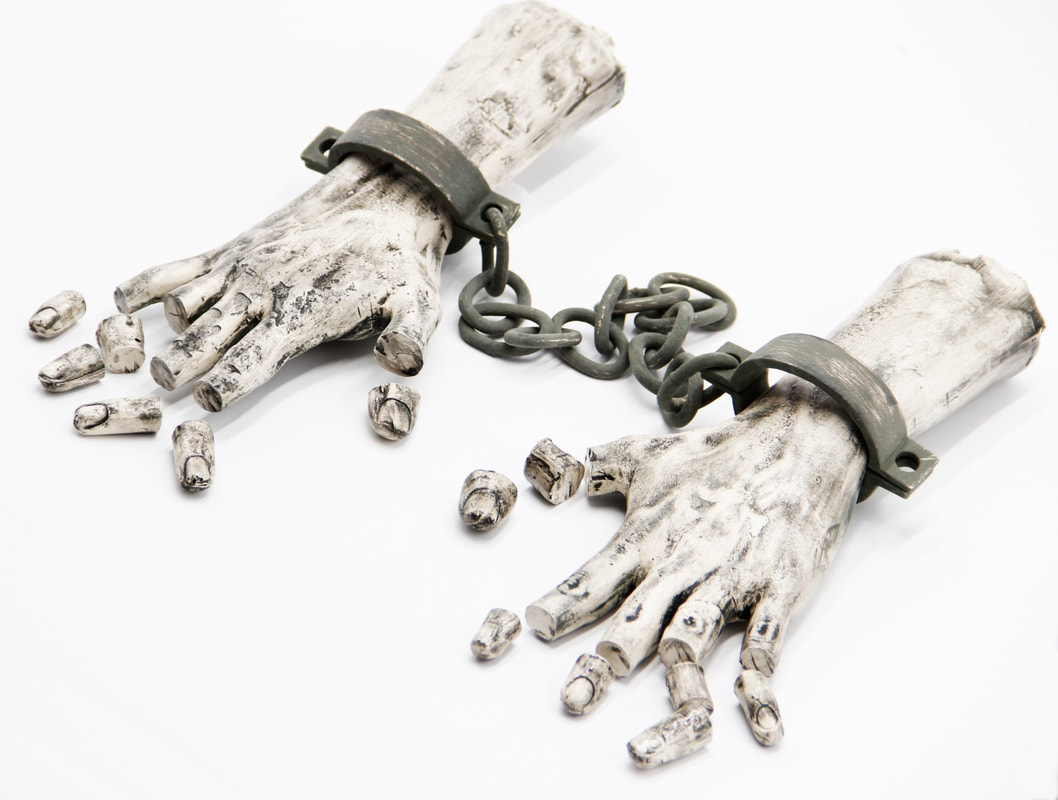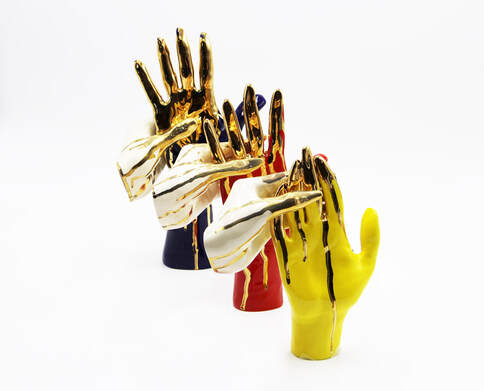Mother of DE‘VIA – Seeds from Within, 2022
Glazed ceramic sculpture
Mother of De’VIA – Seeds from Within, honours Betty G. Miller (1934-2012), “Mother of the Deaf View Image Art (De’VIA)” movement. She was the first to emphasize bold graphic depictions of sign language oppression and later began painting colourful affirmations of the beauty of sign language. Her Deaf resistance art in the early 1970’s was revolutionary and a precursor to the eventual De’VIA Manifesto she and her colleagues articulated in 1989. Miller represents Deaf cultural ancestral seeds that grow from within.
This sculpture pays homage to her famous ink painting, AMESLAN (aka American Sign Language [ASL]) Prohibited, (1972) and celebrates the beauty of ASL painted in the renowned acrylic, Growing with ASL (1992). Hafizirad sculpts two roughly textured black and white handcuffed hands tied together by wire with finger-tips broken off – like a withering plant. This is juxtaposed with a contrasting colourful sculpture series, symbolic of the sign “grow” with a progression of three vibrantly glazed hands emerging well-nourished - watered by golden hands. ASL, “as good as gold”, like the air we breathe and the watering of plants, gives us life. With ASL we flourish.
Glazed ceramic sculpture
Mother of De’VIA – Seeds from Within, honours Betty G. Miller (1934-2012), “Mother of the Deaf View Image Art (De’VIA)” movement. She was the first to emphasize bold graphic depictions of sign language oppression and later began painting colourful affirmations of the beauty of sign language. Her Deaf resistance art in the early 1970’s was revolutionary and a precursor to the eventual De’VIA Manifesto she and her colleagues articulated in 1989. Miller represents Deaf cultural ancestral seeds that grow from within.
This sculpture pays homage to her famous ink painting, AMESLAN (aka American Sign Language [ASL]) Prohibited, (1972) and celebrates the beauty of ASL painted in the renowned acrylic, Growing with ASL (1992). Hafizirad sculpts two roughly textured black and white handcuffed hands tied together by wire with finger-tips broken off – like a withering plant. This is juxtaposed with a contrasting colourful sculpture series, symbolic of the sign “grow” with a progression of three vibrantly glazed hands emerging well-nourished - watered by golden hands. ASL, “as good as gold”, like the air we breathe and the watering of plants, gives us life. With ASL we flourish.
The Story of my world
2020. Glazed ceramic, each approximately 9 x 5 x 3 inches.
This work references Hafizirad’s journey as a Deaf adult into signed language after a childhood in which she was trained to communicate through oral and aural language. In Hafizirad’s narration of the meaning of the piece, she describes the gold plating on some of the fingers of the hands as referencing the preciousness and magic of signed communication. Her journey of coming to signed language as an adult describes one that many deaf people raised with oral education go through. The myriad shapes of the ceramic hands are set in relief of negative space. The property of ceramic – at once solid and delicate – seems to suggest the fleeting nature of language, and its persistent ways of staying with us. The work, understood here in the context of Crip Ritual, suggests that accessing the deaf community through signed language is a ritual process that carries Hafizirad into a new life phase.
Hafizirad further shares:
“Deaf people have vibrant colourful lives expressed through our signing. When you enter a room and see the flurry of signs – that is our colourful life. Growing up in Iran I was forbidden to sign and raised orally. When I moved to Canada I was exposed to American Sign Language and became immersed in the sign language of my people and found my identity as a Deaf women. Now I am in the centre of my vibrant community. I wish others to see what I see – the richness and beauty of our signs and lives.”
This work references Hafizirad’s journey as a Deaf adult into signed language after a childhood in which she was trained to communicate through oral and aural language. In Hafizirad’s narration of the meaning of the piece, she describes the gold plating on some of the fingers of the hands as referencing the preciousness and magic of signed communication. Her journey of coming to signed language as an adult describes one that many deaf people raised with oral education go through. The myriad shapes of the ceramic hands are set in relief of negative space. The property of ceramic – at once solid and delicate – seems to suggest the fleeting nature of language, and its persistent ways of staying with us. The work, understood here in the context of Crip Ritual, suggests that accessing the deaf community through signed language is a ritual process that carries Hafizirad into a new life phase.
Hafizirad further shares:
“Deaf people have vibrant colourful lives expressed through our signing. When you enter a room and see the flurry of signs – that is our colourful life. Growing up in Iran I was forbidden to sign and raised orally. When I moved to Canada I was exposed to American Sign Language and became immersed in the sign language of my people and found my identity as a Deaf women. Now I am in the centre of my vibrant community. I wish others to see what I see – the richness and beauty of our signs and lives.”







